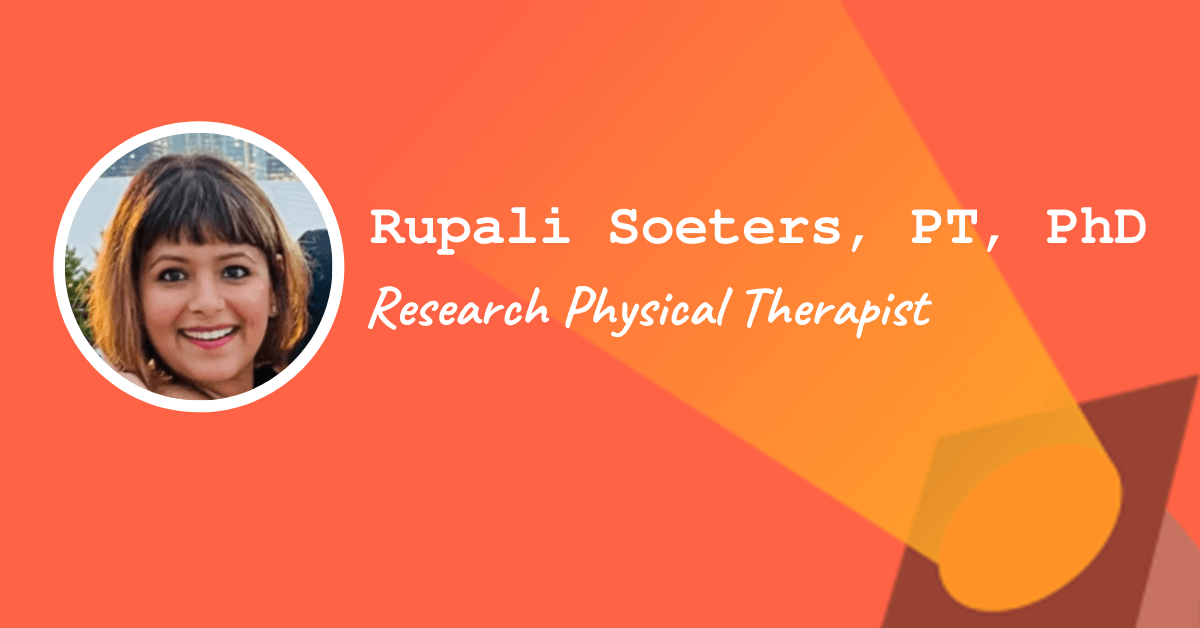Today’s non-clinical spotlight focuses on Rupali Soeters, PT, PhD, who created her own role as a research physical therapist at Hospital for Special Surgery (HSS).
This post may contain affiliate links or codes. This won’t increase your cost, but it helps keep TNCPT alive, and free of annoying ads! Thank you for your support. 🙂
What’s your name and full title?
Rupali Soeters PT, PhD, Research Physical Therapist at Hospital for Special Surgery
Do you still treat patients or are you entirely non-clinical?
I am about 20% clinical and 80% research.
Where did you attend PT school and when did you graduate?
I attended school in India and graduated in 2003.
Why did you initially pursue PT?
My exposure to the field of healthcare—mainly with rehabilitation—began at a young age. My mother, who suffered from poliomyelitis, used to take me along for her physical therapy and her bracing appointments on yearly basis. As a result, it was natural for me to choose a career in physical therapy.
What did you like about PT?
Being a national level gymnast and yoga practitioner in India, I found using exercise for making people’s clinical condition better was very fascinating to me. Also, I was very familiar with exercise and its applications.
What did you dislike/find frustrating about PT?
PT did not go into depth about clinical conditions nor did it offer practical experience as much as it should. Also, once I started practicing, it was not too hard to notice how treatment gets limited due to insurance, how low compliance is not held accountable for or how treatment is more about quantity than quality. I felt like I was doing more paperwork for reimbursement and liability than actual treatment.
At what point did you start to consider a non-clinical career?
To gain deeper knowledge, right after obtaining my undergraduate degree in physical therapy in India, I decided to pursue masters in exercise physiology at Temple University. I developed an additional interest in basic sciences and decided to pursue my PhD in bone tissue biomechanics.
My doctorate focused on studying reproductive abnormalities and their effects on bone development. This animal model mimicked the clinical problem of delayed puberty in gymnasts and anorexic females resulting in early development of osteoporosis. Being a national level gymnast in India, this topic to me was of tremendous interest. I kept following my heart.
Upon completion of my studies, I moved to NYC to gain clinical experience in orthopedic (my PhD focus on bone development) physical therapy (I had my undergrad in PT). After trying few jobs as PT, which were very disappointing, and rejecting few academic positions (I didn’t think I was ready yet for it), I almost packed my bags to leave for India. This is exactly when I got a call from Hospital for Special Surgery (HSS). I went for the interview and accepted a position as PT in January, 2011.
My position at the Hospital for Special Surgery (HSS) allowed me to gain clinical proficiency in orthopedic rehabilitation from conservative management to acute care for post-surgical patients.
How did you transition from a clinical role to a non-clinical one?
My transition into clinical research occurred as a result of simple observations during my acute care posting as a staff physical therapist. I initiated and completed clinical trials to test and compare existing care model to a new model of care delivery. I have been able to identify and target patient needs within our institution that benefit patient recovery and create value for our patients and the institution.
I have single handedly developed and designed the initiatives and research studies along with the non-clinical process improvement projects to address specific areas of focus to improve care delivery and clinical outcomes. Findings from all of my studies/initiatives have led to changes in standard of care at our institution.
My non-clinical PT career was simply by chance. My education allowed it to bloom along the way. No education is ever a waste!
Did you work with any professionals along the way when you decided to go non-clinical?
Yes, my mentors during Masters and PhD program (Drs. Vanessa Yingling, Zebulon Kendrick and Fayez Safadi) that all had various backgrounds ranging from biomechanist, engineer, anatomist and statisticians. This allowed me to see the importance how multiple disciplines are important to shape any idea. My surgeon mentors(Drs. Amar Ranawat, Micheal Alexiades and Thomas Sculco) guided me along the way to develop my ideas into research projects. HSS Rehabilitation leadership (JeMe Mosca, Mary Murray Weir, Charles Fisher, Aviva Wolff) fostered my growth. They allowed for my growth and supported me. Leadership support is critical. I am now mentored by Dr. Stephen Lyman who volunteered to support my projects and guide me along the way.
What does your role entail?
My career at HSS has spanned an array of professional experiences, from direct intervention as a treating clinician and consultant with orthopedic surgeons and researcher at Hospital for Special Surgery. In this capacity, in my current role as a research therapist, I am uniquely positioned to facilitate and lead collaborations between surgeons, multi-specialty physicians, epidemiologists, biomechanists, and rehabilitation specialists.
My career focus and vision is to proliferate findings and implement change on a large scale to better close the “know-do” gap, the chasm that exists between what we know from our research and scientific evidence and what we do in our daily practice to deliver value to our community and reduce the burden on our healthcare system. I strongly believe that focusing on understanding patients’ needs and where the gaps exist, patient centric care models, multi-disciplinary collaborations and utilizing data to drive decisions have allowed me to successfully implement outcomes within our institution.
What’s a day in the life like for you?
Here are some of my responsibilities as a Principal/Lead Investigator:
- Conceptualization and development of new study designs
- Manage project budget, data and timelines
- Vendor selection as applicable and contract negotiations
- Identify potential risks to performance, timeliness and quality of results and develop appropriate plan of action
- Build and maintain productive work relationships with internal/external stakeholders to optimize operations
- Establish effective reporting and communication procedures within and outside the department
- Report on performance of program portfolio to executive leadership
- Write abstracts and manuscripts to be submitted to peer reviewed journal
- Present at national and international conferences
- Develop tools to monitor value-based programs, including monthly reports focusing on targeted interventions and clinical outcomes in relation to cost
- Serve as the direct liaison between rehabilitation and multiple stakeholders across the hospital in coordinating implementation of evidence-based protocols
- Work with leadership to develop operational readiness during project implementation.
- Participate in Hospital committees (Patient and community education, Rehabilitation Clinical Review Panel, Patient Quality Committee)
- Train PT staff, students, research assistants and staff from other hospital teams on regular basis
- Update various hospital departments and stakeholders on research updates and upcoming clinical implementations
And, because I do see patients about 20% of the time, I spend that time evaluating and treating post-surgical patients once a week.
What made you decide to pursue this particular role at your particular company?
I chose HSS for its specialty in orthopedics. I was hired as a full-time PT, as they were not sure where and how my education would fit in their institution. I observed gaps (clinical and non-clinical) and started researching on ways to improve them. I spoke to a lot of people that were involved and collected feedback.
My job description was then changed to do research but I think I have gone beyond the description. I pretty much pick up any gap and convert it into a project. I do what I do because I am passionate about bringing a positive change in lives of our patients and my coworkers.
What steps did you take to land the role? Did you tailor your resume/cover letter specially, etc? Network?
Not at all. I found an opening for a supervisor for a PT section called integrative care center and called HSS. They offered me a PT job and I took it. I took the job because I liked the person who hired me and also that it was an orthopedic hospital.
I have come to a strong realization that a title doesn’t define who we are and what we do. What defines us is our contribution in the betterment of the society we live in.
Organizations and people around us allow us to contribute and its finally up to us if we want to take that opportunity to make a difference!
What are the pros/cons of your role?
Pros: I get to do what I am good at and what I absolutely love, flexibility, full autonomy and freedom to express ideas and opinions
Cons: None
What are some skills that someone should have to apply for a role like yours?
- PT (clinical degree)
- PhD (basic science to give you in depth knowledge)
- A lot of work experience leading projects and implementing results
- Six sigma (an add on)
What excites you the most about what you’re doing?
That I work with like minds in solving problems to improve patient outcomes and create value. I absolutely love problem solving, gathering buy-in, collaborating, working with teams that bring various expertise, and then coming up collectively with a solution based on scientific evidence or data to implement change. There is nothing more exciting than being a part of change.
What are your career goals?
My career focus and vision is to proliferate findings and implement change on a large scale to better close the “know-do” gap, the chasm that exists between what we know from our research and scientific evidence and what we do in our daily practice to deliver value to our community and reduce the burden on our healthcare system.
What would you tell a clinician who is considering going non-clinical but afraid of the judgment?
What judgment? Who is judging? I have been able to offer more value in this role. Do what you best at and don’t be afraid of consequences. If you put in your 100%, a good outcome is inevitable.
Do you have any specific tips for a clinician who doesn’t know where to start with making the move out of patient care?
Speak to a lot of non-clinical PTs and any areas that may fascinate you, network, attend meet-ups, look at other people’s profiles. It helps a lot in understanding career trajectories and options that are out there. Of course, you may also end up creating a position for yourself, like I had to. But at the end of the day, it should be something you are deeply passionate about.
Thanks for your insight, Rupali!




